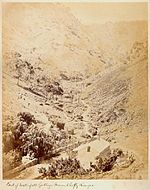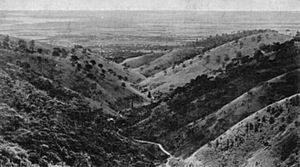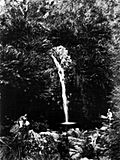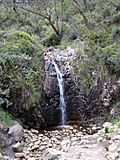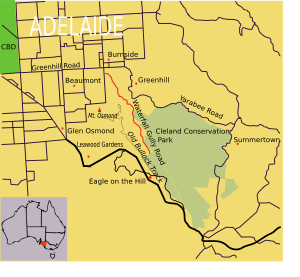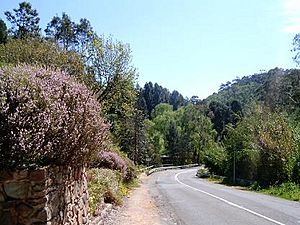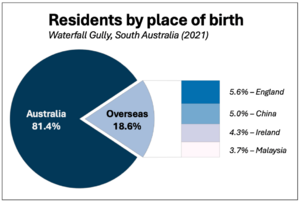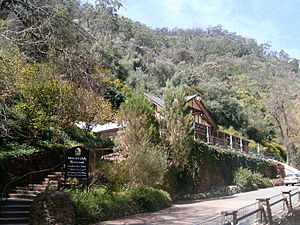Waterfall Gully, South Australia facts for kids
Quick facts for kids Waterfall GullyAdelaide, South Australia |
|||||||||||||||
|---|---|---|---|---|---|---|---|---|---|---|---|---|---|---|---|
| Postcode(s) | 5066 | ||||||||||||||
| Area | 1.9 km2 (0.7 sq mi) | ||||||||||||||
| Location | 10 km (6 mi) from Adelaide city centre | ||||||||||||||
| LGA(s) | City of Burnside | ||||||||||||||
| State electorate(s) | Bragg | ||||||||||||||
| Federal Division(s) | Sturt | ||||||||||||||
|
|||||||||||||||
| Footnotes | Adjoining suburbs | ||||||||||||||
Waterfall Gully is a beautiful suburb located in the eastern part of Adelaide, South Australia. It sits at the base of the Mount Lofty Ranges, about 5 kilometers (3 miles) east of Adelaide's city center. The suburb is mostly a long valley, with First Creek flowing through its middle and Waterfall Gully Road running alongside it. At the end of the valley, you'll find First Falls, a lovely waterfall that gave the suburb its name.
Waterfall Gully is part of the City of Burnside. It is surrounded by other suburbs and natural areas. To the north is Burnside, and to the east and south-east is Cleland National Park. To the south is Crafers West, and to the west are Leawood Gardens and Mount Osmond.
European explorers first visited Waterfall Gully in the early 1800s. It quickly became a popular spot for tourists and picnics. The government kept control of some parts of the area until 1884. Then, they gave the land to the City of Burnside. Later, in 1912, the government took back control of the southern part of Waterfall Gully. They made it South Australia's first National Pleasure Resort. Today, this area is still managed by the State Government. In 1972, the Waterfall Gully Reserve became part of the larger Cleland Conservation Park, which is now a national park.
Over the years, many trees in Waterfall Gully were cut down. Early farmers grew different crops and set up market gardens and nurseries. People also tried to mine for minerals, but it wasn't very successful. However, the area had one of the state's first water-powered mills. A weir (a small dam) built in the 1880s helped supply water to parts of Burnside. Today, Waterfall Gully mainly has homes and parks.
Contents
Discovering Waterfall Gully
The Mount Lofty Ranges, where Waterfall Gully is located, were first seen by Matthew Flinders in 1802. The gully itself was found soon after Adelaide was settled. Colonel William Light, who planned Adelaide, is said to have chosen the city's location while looking at the plains from the hills near Waterfall Gully. However, people lived in the gully long before Europeans arrived. The native Kaurna people lived in the area for up to 40,000 years.
The Kaurna People and Their Land
In Aboriginal mythology, Waterfall Gully and the Mount Lofty Ranges are part of the story of the ancestor-creator Nganno. Nganno was wounded in a battle and lay down to die, forming the Mount Lofty Ranges. The peaks of Mount Lofty and Mount Bonython were formed by Nganno's ears. The region was called Yur-e-billa, meaning "the place of the ears." The name of the Greater Mount Lofty Parklands, Yurrebilla, comes from this term.
The Kaurna people did not live in the highest parts of the ranges, but they lived on the lower slopes. An early settler, James Milne Young, described seeing many Kaurna people camped in the area. He said, "At every creek and gully you would see their wurlies [simple Aboriginal homes] and their fires at night." Their main camps were along the River Torrens and its creeks, including First Creek in Waterfall Gully.
The land around Waterfall Gully provided many resources for the Kaurna people. They used bark from local stringybark trees (Eucalyptus obliqua) to build winter huts. Stones and native timbers were used for tools. They also found food like cossid moth larvae and other plants and animals. However, hunting and gathering food were generally easier on the rich plains nearby.
Early European Exploration
One of the first stories about Waterfall Gully comes from a "Mr Kent" in 1831. He climbed Mount Lofty with Captain Collet Barker and described a ravine with "smooth and grassy sides." This is believed to be Waterfall Gully. Later, Young Bingham Hutchinson and his servant, William Burt, tried to climb Mount Lofty through Waterfall Gully in 1837. Hutchinson wrote that the plants were so thick it was hard to move. He described seeing "a wall of rock about fifty or sixty feet [fifteen to eighteen metres] high, which stretched across the ravine, and from the top of it leapt the brook." This brook was First Creek, and the waterfall they saw is now called First Falls.
However, Hutchinson was not the first European to see First Falls. John William Adams, an emigrant, saw it in early January 1837 and named it "Adams' Waterfall." He was traveling with his wife and others, looking for water in the hills.
How Waterfall Gully Grew
Waterfall Gully quickly became a popular place for early settlers to visit and have picnics. In 1851, Francis Clark called it "the most picturesque place for a picnic." By the 1860s, it was well-known in Adelaide. The government decided not to sell the land with the waterfalls, so the public could always visit it. Visitors could walk down from the Eagle on the Hill hotel on Mount Barker Road, which was a good spot for lunch.
Other parts of Waterfall Gully were sold to private owners. Much of the land belonged to Samuel Davenport. He used his land for timber, grazing animals, and growing crops like olives and grapes for wine. Other local residents ran market gardens and nurseries. For example, Wilhelm Mügge and his wife Auguste Schmidt had a famous nursery and market garden. They also made cheese from their dairy farm.
Besides farming, people cut timber in the hills and along the creek. Several mines were also started in the area in the mid-to-late 1800s. In 1844, the first silver-lead, manganese, and iron mines were opened. The 1890s saw a small gold rush, but only tiny amounts of gold were found. Stone quarrying in Chambers' Gully was more successful, starting in 1863.
Waterfall Gully was also home to Burnside's "first secondary industry." In the late 1830s, Thomas Cain built a watermill on First Creek. It powered a sawmill, which later became a flour mill. The mill operated until the late 1850s, but it was taken apart in the 1880s. Today, only small traces of it remain.
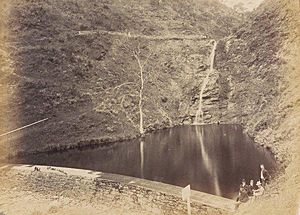
As the nearby village of Burnside grew, it needed more water. First Creek, which flows through Waterfall Gully, was chosen as the solution. A weir was built in 1881 and 1882 to hold about two megalitres (530,000 US gallons) of water. A pipeline carried the water to a reservoir in Burnside South, supplying the surrounding area. This weir also reduced the water available for local market gardens, which eventually disappeared.
While the path to the falls from Eagle on the Hill was public, the route along the gully went through private land. Many visitors still used this route. Public demand and landowners wanting better access led to pressure to build a road through the gully. Despite some local opposition, Waterfall Gully Road was built in the late 1880s.
The new road brought more visitors. People could now take a horse tram to the start of the gully and then walk, cycle, or ride to the falls. Roadside kiosks and produce stalls appeared. The Mügge family even built the two-story Waterfall Hotel. In 1912, the government opened a kiosk at the base of First Falls, designed like a "Swiss chalet." The hotel is now a private home, but the kiosk is still open today.
| In 1880, Second Falls was covered in lush ferns. Today, the ferns have mostly disappeared, and new plant species have taken their place. | |
Protecting Waterfall Gully
Some parts of Waterfall Gully were given to the City of Burnside in 1856. However, the government kept control of a large part of the area. It wasn't until 1884 that the rest of the land was transferred to the Burnside Council. This happened thanks to the efforts of Samuel Davenport and G. F. Cleland.
The land stayed under Burnside Council's control until 1915. Then, the Waterfall Gully Reserve was taken back by the government. It became the first National Pleasure Resort in South Australia. It was first managed by the National Parks Advisory Board, then the Tourist Bureau, and finally the National Park Commission.
In 1945, much of the land that is now Cleland National Park was bought by the State Government. This was largely due to Professor Sir John Cleland. Most of this land was combined in 1963 to create the park. The Waterfall Gully Reserve was added to the park in 1972.
Natural Challenges
Since European settlement, Waterfall Gully has faced both bushfires and floods. Severe bushfires hit the gully in 1939 and the early 1940s. These fires caused a lot of damage because supplies and people were busy with the war effort.
Significant floods happened in 1889 and 1931. On November 7, 2005, Waterfall Gully was one of several areas in Adelaide to experience severe flooding. It was one of the hardest-hit suburbs. Many houses were flooded, two bridges almost collapsed, and 100 meters (330 feet) of road were washed away. Emergency workers and council staff repaired the damage. The suburb was closed to everyone except residents and emergency workers for the rest of the month.
Geography and Nature
Waterfall Gully is about 234 meters (768 feet) above sea level. It covers an area of about 6.08 square kilometers (2.35 square miles). Its most famous features are its gully and waterfall. Langman Reserve, a large local park, is 300 meters (980 feet) from the start of Waterfall Gully Road. Much of the north-eastern side of the gully is part of Cleland National Park.
Next to Waterfall Gully, about 2 kilometers (1.2 miles) away, is Chambers Gully. This area used to be a landfill, but it has been turned into a park by volunteers. It has old ruins, walking trails, and springs. It is also home to many native animals and plants.
Since European settlement, the native plants have changed a lot. Many native manna gum and blue gum woodlands were cleared for farming. A lot of non-native plants are now in the gully because of early farming or by accident. These include olive trees, hawthorn, fennel, and blackberry.
With fewer native plants, non-native animals have increased. These include rabbits, blackbirds, and starlings. However, some native wildlife still lives here. Bats (like Gould's wattled bat), superb fairy-wrens, and Adelaide rosellas can be found. You might also spot Australian animals like kangaroos, koalas, and possums on the walking trails.
Getting Around Waterfall Gully
Waterfall Gully is connected to the main Adelaide road, Greenhill Road, by Waterfall Terrace and Glynburn Road. Most people in the suburb use cars to get around. According to the Australian Bureau of Statistics, about 71.9% of residents drive to work. Only a small number walk (1.3%) or cycle (1.2%). About 3.6% of residents take the bus. The closest bus route is the 142 bus, run by Adelaide Metro.
Waterfall Gully Road is winding and narrow in some places. This has raised concerns about safety, especially for pedestrians and cyclists. After a cyclist died in 2007, people called for the road to be repaired. Two petitions were sent to parliament. A safety check was done, and it suggested looking at the entire road. As of mid-2008, there was no clear plan for the road's future, and it did not receive funding in the state budget.
Who Lives in Waterfall Gully
In 2021, the population of Waterfall Gully was 161 people. About 51% were male and 49% were female. The average age was 40 years old.
Residents of Waterfall Gully generally earn more money than others in South Australia. In 2021, the average weekly household income was A$3,600. This is much higher than the average of A$1,455 per week for all of South Australia. Many people in Waterfall Gully work in professional jobs (41.0%) or as managers (25.3%). In South Australia as a whole, these numbers are lower. Also, 44.7% of Waterfall Gully residents aged 15 and over had a bachelor's degree or higher. This is almost double the rate for all of South Australia (22.7%).
Most people in Waterfall Gully (81.4%) were born in Australia. This is higher than the average for South Australia (71.5%) and Australia as a whole (66.9%). The top countries of birth outside Australia were England (5.6%), China (5.0%), and Ireland (4.3%). The most common ancestries reported were Australian and English (both 30.4%), followed by Scottish (11.2%), Chinese (11.2%), and Irish (9.3%). People could choose up to two ancestries.
Places to Visit
The main attraction in Waterfall Gully is First Falls. It is located at the south-eastern end of the road, within Cleland National Park. The weir at the bottom of the waterfall was built in the late 1800s and was an early part of Adelaide's water supply system. The area has been improved over the years, with better access, upgraded bridges, and new signs.
The Waterfall Gully Restaurant was built between 1911 and 1912 by architects Albert Selmar Conrad and his brother Frank. It was officially opened on November 9, 1912. The building looks like a Swiss chalet and has been heritage listed since 1987. It is said to be haunted by the ghost of a firefighter who died from burns in 1926.
Many fire tracks and walking trails wind through the hills around Waterfall Gully. They branch off from Chambers Gully, Woolshed Gully, or the area around First Creek. You can hike to places like Crafers, Eagle On The Hill, Mount Lofty, Mount Osmond, and the Cleland Wildlife Park. The tracks have been rebuilt and resurfaced in recent years. Some older, more dangerous routes have been sealed because of the difficult terrain. Many trails offer great views of Adelaide and the gully itself. One of these trails connects to the 1200-kilometer (750-mile) Heysen Trail.



